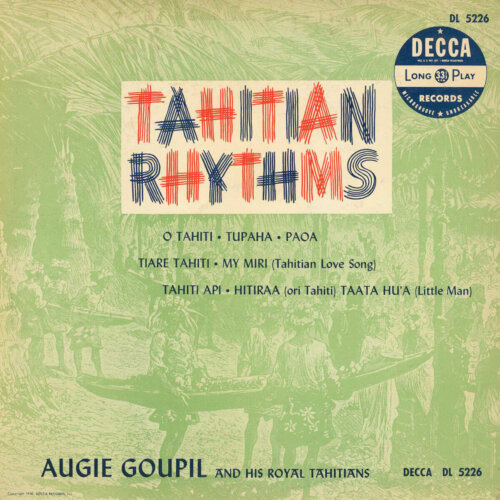Album Title: Tahitian Rhythms
Artist(s): Augie Goupil; Thurston Knudson
Year: 1950
Genre(s)/Style(s): Polynesian
Track Listing:
- O Tahiti
- Tupaha
- Paoa
- Tahiti Api
- Hitiraa (Ori Tahiti)
- Tiare Tahiti
- Taata Hu’a (Little Man)
- My Miri (Tahitian Love Song)
Note: Something off? Please submit any album corrections in the comments.
Liner, Listening & Album Notes:
From the album’s back cover
Notes by Thurston Knudson …
In the eastern part of the South Seas, far from the western world, lies the center of ancient Polynesia — Tahiti and Raiatea of the Society Islands. From this hub, the fabled “Hawaiki,” rugged “Vikings of the Sunrise” sailed in all directions on colonizing voyages which for dis-tance and hazards surpass the feats of the Norse Vikings of the Atlantic Ocean.
Only a short time ago have the descendants of this people become known to us. We did not, in fact, see them in anything like a natural light until release of the silent films, “Moan of the South Seas” and “Tabu.” It has taken still more time for a real presentation of their songs and dance music to reach us. “Augie” Goupil’s selec-tions, here presented, have the authentic ring. It is but to be expected that the harmonies used in this music should be simple. But what one does not expect is the richness, vigor, and complexity of the rhythms. Here is reflected the dynamic urge of those ancient sea-rovers who accomplished the impossible. Natural, but worthy of note, is the fact that in the old homeland, Tahiti, the music should still have more drive and swing than in the outlying colonies—Samoa, New Zealand, Easter Island, the Marquesas, and the Hawaiian group—where the spirit of expansion finally subsided.
The basic rhythm-patterns of Tahiti have much in common with syncopated jungle rhythms around the world; but the way in which Tahiti-ans have elaborated them is characteristically their own. It is true that, like their other Polynesian brothers, they love simple, “sweet” music in slow tempo. This is noticed particularly in their like treatment of missionary hymns and popular songs which have been brought to them since their contact with the far West. But at a native feast in any of the Society Islands, when the entertainment begins the tempos soon be-come faster and the rhythms wilder.
As one would suspect, the drums play a larger part in Tahitian life than they do in other re-gions of Polynesia. In fact, for the formal dance the only accompaniment is an orchestra of percussion instruments carrying at the same time a slow, medium, and fast syncopation all inter-woven in counterpoint. The total effect is powerful; it avoids the monotony of a too simple pattern, but the fundamental meaning is never lost. And the use of this multiple rhythm permeates their playing of other musical instruments—even their singing.
An ancient form of the large drum which still survives in Tahiti is the pahu, made of a hollowed log of either coconut-tree or purau, and covered at one end by a membrane of shark or pigskin. This is played with the left elbow and palm of the right hand. The tone is deep and carries for a long distance. The strictly musical instruments which Tahitians use at the present time are the accordion and harmonica, as well as the guitar and ukulele; use of the latter they have picked up from their Hawaiian cousins. But the Tahitian sense of rhythm is strong. The singing voice, aided by a remarkable control of the diaphragm, renders simultaneously all the primary and secondary syncopated patterns that a full percussion set would perform, no matter how fast the tempo.
About Augie Goupil …
The late Auguste ( “Augie”) Goupil was born in Tahiti in 1910, of French and Tahitian parentage. At the age of eight he came to Berkeley, California, to attend the St. Joseph’s Academy; but he returned to his native land early enough to retain its spirit and traditions. An exception-ally gifted singer and dancer, as well as com-poser, he was convinced that America would appreciate the verve and rhythm of Tahiti, so he returned to California in 1929. The welcome Augie received in San Francisco’s night life proved his intuition well founded. He appeared in a number of sound films, culminating in his appearance as the originator of the Tahitian drum dance in “Waikiki Wedding.” Decca has presented several series of Goupil’s Tahitian recordings with wide acceptance by the public. But certain of his more rhythmic numbers were so stirringly authentic it was decided to offer them in the form of the present collection.
About Thurston Knudson…
Thurston Knudson, composer and arranger of native rhythms, is the soloist on the native drums on several of the numbers in this selection of Augie Goupil’s Tahitian recordings. A Phi Beta Kappa graduate of the University of California, majoring in philosophy and psychology, and later a teacher in Oakland and San Francisco, he went to Tahiti in 1923 to find the answer to a problem which had long intrigued him—the origin of the jazz rhythm-pattern. Mr. Knudson visited all districts of Tahiti and Moorea, and pounded with the natives on the village drums. Further analysis revealed the secret of their complex multiple rhythm—a cycle of eight syncopated rhythms, all derived from the simple original one. By a mathematical table of permutations he obtained 1,680 contrapuntal rhythms serving as bases for new compositions.
Album Preview:
